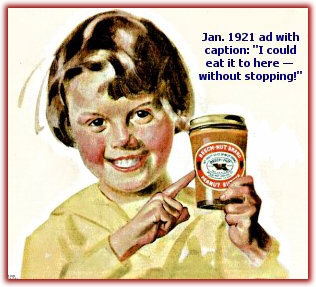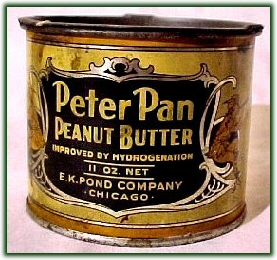 According to “The Story of a Pantry Shelf, a book
published in 1925:
According to “The Story of a Pantry Shelf, a book
published in 1925:
Thursday, November 30, 2006
Page 11
REMINISCING (Column)
Top Selling Peanut Butter Once Was Beech-Nut
By ROGER M. GRACE
The major manufacturer of peanut butter in the early 20th Century was Beech-Nut…yes, the outfit we now know strictly as a baby food maker.
“Beech-Nut” was once a name affixed to a broad line of products. I’ve run across that brand in researching past columns on both mustard and ginger ale.
 According to “The Story of a Pantry Shelf, a book
published in 1925:
According to “The Story of a Pantry Shelf, a book
published in 1925:
“The story of Beech-Nut is a typical romance of American business. It is the story of several country boys in Canajoharie, New York, ‘all going in together,’ to make fine and wholesome foods.
“They started with hams; then bacon….
“The company was incorporated in 1891 with a capital of $10,000. It was first known as the Imperial Packing Company, but in 1898 this was superseded by the name ‘Beech-Nut Packing Company’…
“[B]acon was followed by peanut butter, and peanut butter by jams and jellies. Then came pork and beans, catsup, chili sauce, mustard, spaghetti, macaroni, marmalades, caramels, fruit drops, mints and chewing gum—and now coffee.”
I remember the chewing gum from my childhood, buying packs of it from the Bay Pharmacy in the Pacific Palisades in the early 1950s. The gum, available into the 1980s, probably outlasted all of the Beech-Nut products other than the baby food—which, incidentally, was not added to the line until 1931. (The baby food survived a mini-scandal in 1987, as you probably recall. It was bared that Beech-Nut’s supposed apple juice was nothing more than sugar-water with artificial flavoring.)
Looking back to the heyday of Beech-Nut Peanut Butter, a 1915 ad read:
“In the age of Domestic Study, the feeding of children has changed—wholly for the better.
“Nowadays the Mother consults a child’s tastes—knowing that a Beech-Nut peanut butter sandwich, for instance, is all the more nutritious because it appeals to the palate.”
The claim that a product is “all the more nutritious because it appeals to the palate” might be somewhat difficult to substantiate scientifically.
An April, 1923 ad in the “People’s Home Journal” for Beech-Nut Peanut Butter specified that “No shells or skins, no stones or broken kernels, find their way into this flavorsome Beech-Nut product”…implying that other brands did contain shells or skins, etc. Of course, “broken kernels,” that is, pieces of nuts, were originally customary in the product, and the presence of nut pieces was later to render the paste “chunky style.”
I have no recollection of Beech-Nut Peanut Butter. Andy Rooney wrote in a 1991column that “[a]s a child, you got to like whatever brand of peanut butter your mother bought,” adding: “We always had Beech-Nut Peanut Butter.” My mother bought Peter Pan or Skippy.
Occasionally, she would purchase Laura Scudder Peanut Butter. That brand had oil on the top of the mass, which had to be stirred in. That was the way peanut butter came when she was a child, she recalled.
The process for preventing oil separation was developed in
1922 by Joseph L. Rosefield, who soon licensed the process, which he patented,
to Swift & Company. That outfit made Pond Peanut Butter which, in 1928, it
re-dubbed “Peter Pan.” An item in the Fitchburg (Mass.) Sentinel on June 13,
1928, read:
licensed the process, which he patented,
to Swift & Company. That outfit made Pond Peanut Butter which, in 1928, it
re-dubbed “Peter Pan.” An item in the Fitchburg (Mass.) Sentinel on June 13,
1928, read:
“Peter Pan Peanut Butter is a new style product. It is hydrogenated peanut butter—which means that it has been treated with hydrogen—an element which imparts smoothness. 35¢ can.”
Rosefield had a parting of ways with Swift in 1932, and Rosefield Packing Company Ltd. in Alameda began manufacturing its own brand of peanut butter, Skippy. According to a 1947 federal trademark application, the first use of the name was on Feb. 1, 1933.
A May 12, 1933 ad in the Reno Evening Gazette described the product as “smooth as butter and improved by hydrogenation.”
Rosefield is generally credited with having soon after developed “chunky” peanut butter by mixing in chopped peanuts at the end of the process.
In 1958, Procter & Gamble introduced a new brand of peanut butter, Jif, which became the top seller.
Nowadays, Milnot Holding Corporation owns Beech-Nut; The J.M. Smucker Company, which makes Smucker’s Peanut Butter (fancied by Rooney), owns Jif and Laura Scudder. Skippy belongs to the multinational Unilever, and Peter Pan is a property of ConAgra.
Copyright 2006, Metropolitan News Company